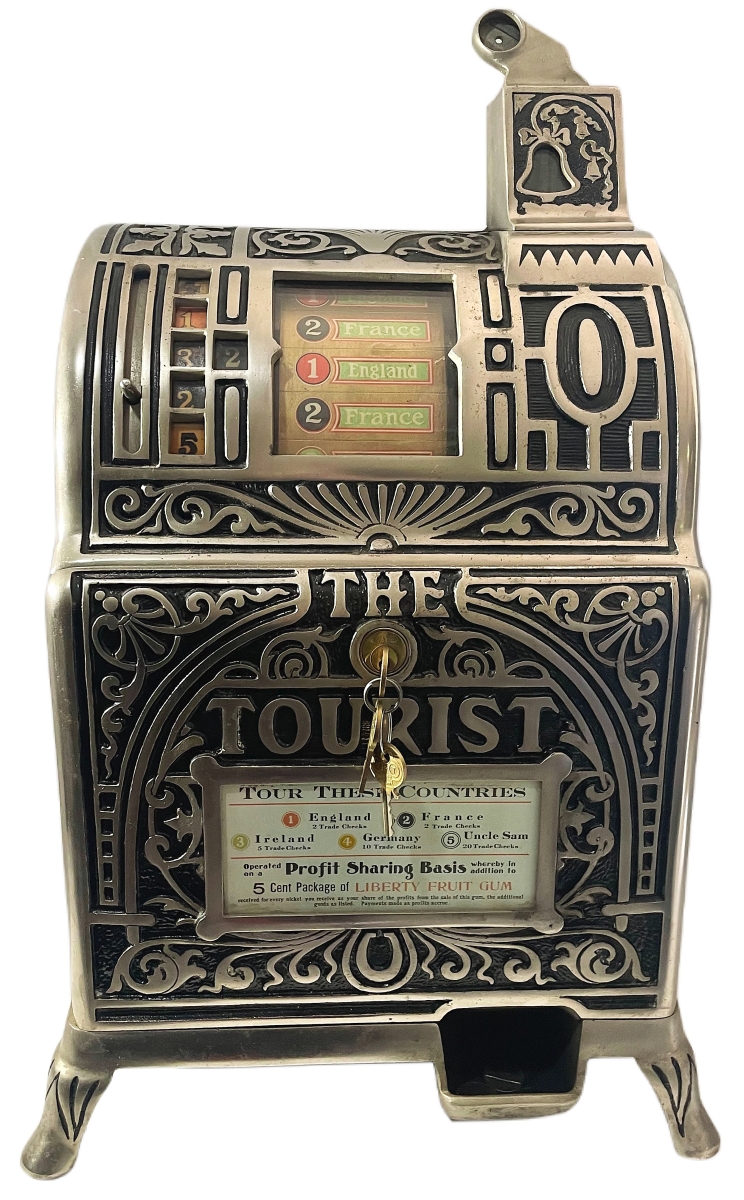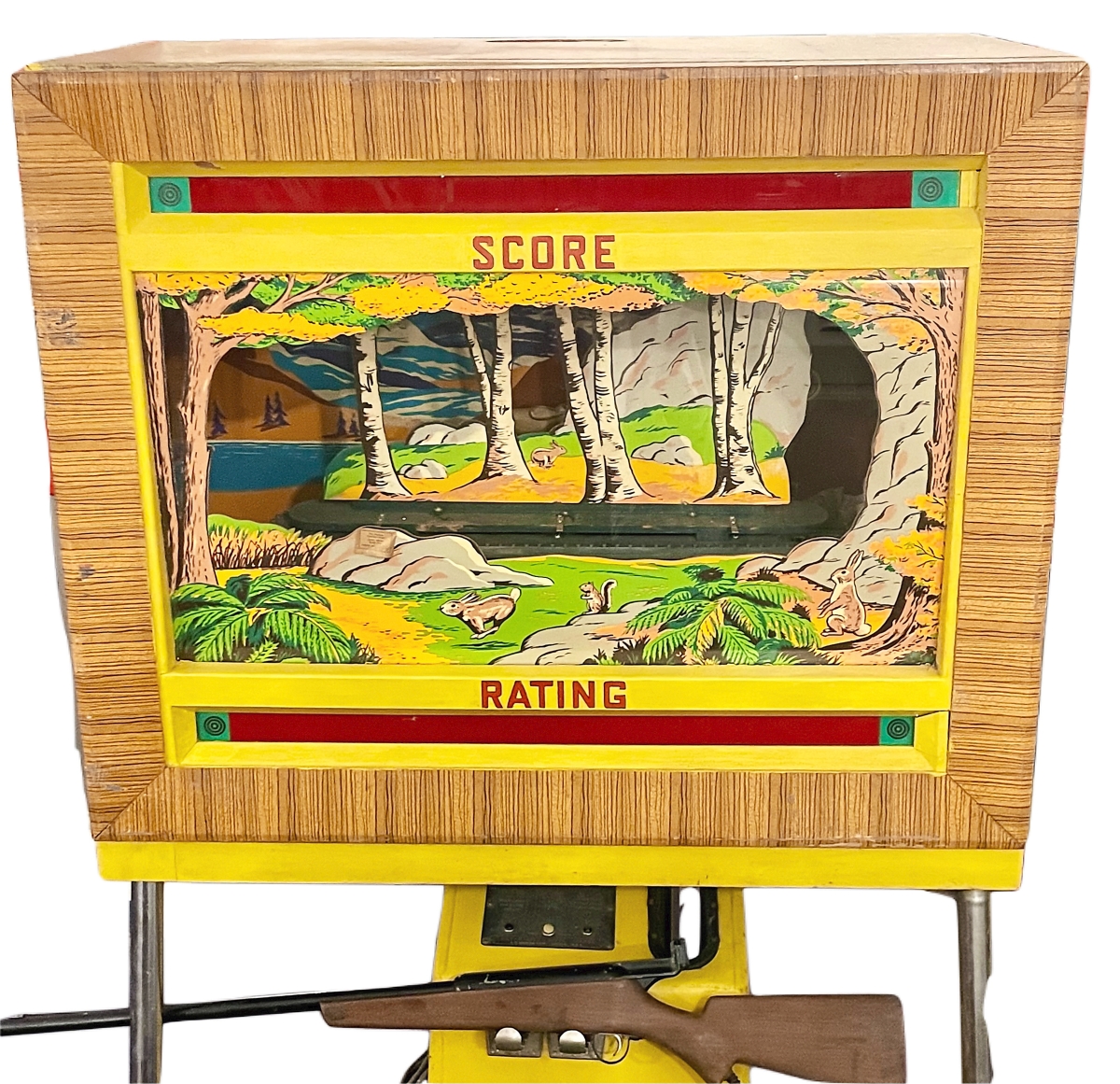
The ultimate Paul Fuller designed Wurlitzer is this extremely rare 1942 wall mounted Remote Speaker with record selector box. It selected a $45,100 winning tune and was the top-seller of the auction ($16/50,000).
Review by Marty Steiner, Photos Courtesy Preston Opportunities
MACON, GA. – It was plenty hot in Macon over the Labor Day weekend, but the real heat was being generated by the bidding at Preston Opportunities “Spectacular Coin-op and Jukebox Auction” on September 3. With more than 40 bids rocking back and forth between two very serious bidders, a Wurlitzer Remote 430 speaker with wall box blared out a $45,100 tune, the top price achieved in the sale. This met the estimate of $16/50,000.
Designed in 1942 by Paul Fuller (Fueller), experts point out that a small original production – combined with the passage of time – suggest there may be fewer than 20 of these remote speaker units still in existence. This example includes a remote selector box centered between plastic pilasters, all housing a large speaker. One of the last documented sales of a Wurlitzer Remote 430 was in 2011, when it brought $18,000.
Three of the four top-resulting lots made sweet music for pieces by Wurlitzer. All were Paul Fuller designs with many utilizing Catalin plastics, all with vivid colors and lighting effects. The jukeboxes were grouped near the end of this 570-lot sale, the top seller was followed by an iconic Wurlitzer Peacock 850. So named for its front glass panel with a pair of peacocks illuminated by a sequence of flashing and changing colored lights. Featuring bubble panels and the overall Art Deco extravagance, this was the peak of Wurlitzer, introduced just as World War II engulfed both lifestyles and materials availability. It brought $18,700, seventh in this sale.
Next up was a model 950, the first design produced as the war took full effect. With only 3,400 ever produced, this restored example placed third overall in this sale at $31,900, a result that landed squarely within its estimate. The first of this Wurlitzer group was a full size, nearly 4 feet high, Model 580 remote wall speaker. In the overall shape of a full jukebox, central floral glass panel framed with a cutout wood panel with the word “music,” it also sold for $31,900.

The “Little Monte Carlo” is a 5-cent nickel driven roulette wheel made by the Mills Brothers of Chicago. Prizes are provided by the proprietor; this one provides cigars. The automated cigar salesman earned $29,150 ($11/35,000).
For the Wurlitzer fan that can’t manage to bid on these machines, three late 1940s-50s Wurlitzer wall posters were sold. Three original “Wurlitzer Phonograph Music…Musical Fun for Everyone” posters with phrases to encourage use of its jukeboxes brought $1,320, $1,650 and $1,870, all exceeding estimates.
Music boxes and actual instruments that utilized paper rolls – or later, metal disks – to play songs preceded recorded music. Two paper roll operated hand-crank table-top organs dating from the late 1800s were offered. A tabletop Clariona bellows organ driven by paper rolls brought $385, and a Gately Automatic “Expression” Organ in gold stenciled oak cabinet sold for $330.
The history of the “nickel in the slot phonograph” coin-operated music playing machines parallels mankind’s evolution of communicating. The invention of recording devices included the spoken word and later, music. Thomas Edison’s first wax cylinder recording devices gradually also became used to record and play back music. In 1889, two inventors in San Francisco developed a coin-operated machine that allowed listening to an Edison phonograph record through “listening tubes” (predecessor of the headset and ear buds). In 1918, the Automated Music Instrument Company (AMI) developed a coin-operated machine that played different tunes on actual instruments in the machine. They also developed a record changer. Justus Seeburg designed machines with multiple turntables, each with a different recorded song. Examples of many of these generations of coin-operated music machines were sold in this sale. The place of the jukebox in America was honored by the United States Postal System in 1995 when a 25-cent jukebox stamp was issued as part of its American Culture series.

No need to go to the racetrack if you can get to a Bally “Ray’s Track” machine. With nickel or quarter bets on the nine “Rays Horses,” or if you prefer $7,700 to own the whole track in an Art Deco marquetry cabinet ($8/28,000).
But jukeboxes are just the glitzy part of the coin-op collectibles. To appreciate this auction requires an understanding of the full universe of coin-operated devices. This sale featured jukeboxes, gambling and slot machines, arcade machines, trade stimulators, fortune tellers, scales, mutoscopes, skill testers and vending machines.
Four of the top seven lots in this sale were gambling machines, with three of these by the Caille Brothers. The winner in gambling machines at $43,450 was the Caille Brothers “The Tourist.” Housed in an ornate nickel-plated cast iron cabinet, this machine offered destinations rather than the three fruit images on the rotating wheels of the more traditional slot machine. A Caille “New Century Detroit” unit with a single vertical disc housed in a quartersawn oak cabinet brought $22,000, while their “Silver Cup” with two vertical discs in ornate cast iron case drew $17,820. A Mills Novelty Company “Monte Carlo” roulette wheel machine hit $29,150. Other formats included mechanical horse races. It should be noted that some states don’t allow gambling machines to be sold to their residents.
The predecessor of today’s video arcade was the penny arcade. Filled with machines that told fortunes, tested one’s strength, provided a “peep show” or simply provided their weight.
Long before live-streaming, or “talking” or silent movies, was the mutoscope. Developed in the 1890s, it utilized a set of black and white photos mounted on tough flexible cards attached to a center Rolodex-like core. The set was flipped by depositing a coin and viewed by only one person through a hooded viewer. Two early examples with a single one-minute show sold for $660 and $440. A Mills Viewer Quarterscope offered the option of four different “ladies” shows for $5,225.

This unusual early Twentieth Century Caille Brothers “The Tourist” gambling slot machine presents only two wheels with numbered tourist city destinations. Housed in a nickel-plated ornate cast iron case, the successful bidder spun it to $43,450 ($20/59,000).
Perhaps designed to allow kids to drop their gumball on the floor as it rolled down from the glass globe, more than a dozen glass globe gum ball dispensers were sold. The top lot, a dispenser of Pulver “One Cent delivers a Tasty Chew” packaged chewing gum drew $1,045. A 1937 Jennings 5-cent Cigarola machine combined the classic three-wheel slot machine with a cigarette vending machine. Combined bids for this machine only reached $3,300, which was short of presale expectations.
Among the miscellaneous coin vending devices were four napkin holders that also offered an IQ test, or Swami fortune telling with “yes” or “no” answers to your question. The napkins were free but depositing a penny in the coin slot dispensed a small ticket with your IQ question or the fortune-telling “yes” or “no” answer. Loaded with original tickets they ranged from $275 for the IQ up to $468 for a Madam X fortune teller.
As in any collectibles area, good information is important to any collector, new or seasoned. One source in this collecting genre is the Vintage Arcade Preservation Society (VAPS). In addition to online information (www.vaps.org), they also list some print reference books. This organization boasts 12,000 members across 70 countries with 150,000 machines and nearly 7,000 games.

Known as both the “Gazelle” and the “Victory” jukebox, the 1942 Wurlitzer 950 faced World War II material shortages, so only 3,400 were ever manufactured. No shortage of bidders or bids with $31,900 taking this one home ($25/60,000).
Preston Opportunities provides an unusual mix of sales. The sale reviewed here had both live onsite and internet bidding and was followed by a Sunday sale that had no online bidding or catalog platform. “We call it an Old Fashioned Auction, held outside, and this year we all cheered on our chosen horse as we demonstrated the Baker’s Pacers machine,” Preston Evans, the firm’s owner and auctioneer said, referring to a machine demonstrated in an online video that sold for $12,100, well within its estimate.
“Jukebox collecting is not a fad,” he continued. “It’s been going on for a long time and is only growing! Our motto this year was to place your money on a collectible and enjoy yourself while that investment grows.”
Prices in this review include the buyer’s premium as quoted by the auction house but may not include additional online buying surcharges. For more information, www.prestonopportunities.com or 478-461-4931.


















